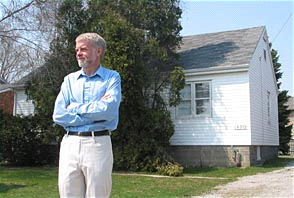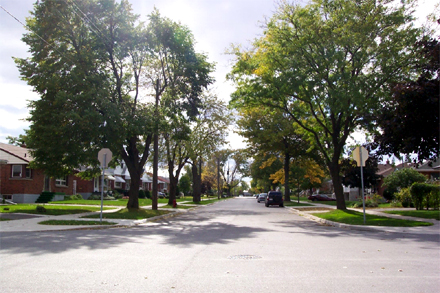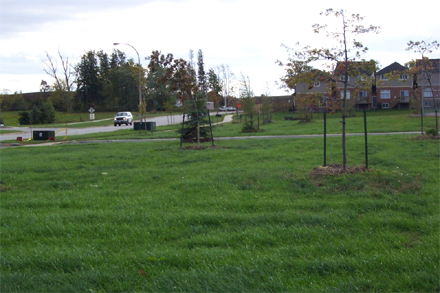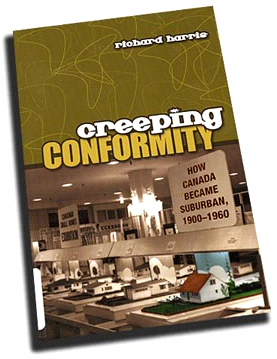Professor Richard Harris talks to RTH about the logic of suburbia and the future of sprawl.
By Trey Shaughnessy
Published October 21, 2005

Richard Harris is a professor and associate director of the School of Geography and Geology at McMaster University. He is an expert in 20th century urban geography, specifically Canadian and American cities and housing. He has authored many books, including his latest, Creeping Conformity: How Canada became suburban, 1900-1960 (University of Toronto Press, 2004). Earlier this year he was awarded a 2005 Guggenheim Fellowship - the only academic from a Canadian university to win such honour this year.
I would like to congratulate Richard Harris on behalf of Raise the Hammer for being awarded such a prestigious fellowship and thank him for this email interview.
Trevor Shaw, Raise the Hammer: Every generation that has moved into the suburbs has continually added to the sprawl that consumed the adjacent greenspace - usually with resistance from the previous inhabitants. Do you see suburbs continuing on this path?
Richard Harris: Yes and no. (There's a classic academic response for you!) Yes, because most new development is still going to happen at the urban fringe, and consume greenspace. No, because it doesn't have to take the form of sprawl. There's a choice, and I think that our choice is changing, slowly.

Richard Harris surveys new housing development in a Hamilton neighbourhood. The
house behind him was part of a post-war development, the beginning of suburbia.
(Image Credit: McMaster University)
TS: Recently massive suburbs like Pasadena, California and around Atlanta, Georgia have been urbanizing their suburbs - traditional street grids, wide sidewalks, narrow streets, mixed-use buildings, walkable shopping destinations, front porches and higher density populations - called New Urbanism.
The problem is New Urbanism is only applied to new developments. In Canada and the U.S. there are massive areas of existing post-war suburbs. Can the existing suburbs have New Urbanism ideals integrated?
RH: In bits and pieces, yes, though it's a big challenge. Existing residents tend to resist increases in densities, and/or attempts to introduce small-scale commercial activity into residential areas. Australia has aimed at intensification by allowing, and encouraging, home owners to build 'granny-flat' extensions or, on large lots, additional structures. They've met with rather limited success.
By the way, don't overlook the fact that there are New Urbanist developments in southern Ontario. In fact, the largest such development in North America is Cornell, in Markham. The real problem is that individual New Urbanist developments, even on the scale of Cornell, don't make much difference. Most households still end up owning two-plus cars, because the wage-earners have to commute someplace else.

East 43rd Street in Hamilton. A suburb built on a grid of streets, circa 1950s.
TS: Where do you think the desire to change the existing suburbs will come from - government, consumers, builders or market forces such as higher energy costs?
RH: Builders respond to consumers. Most consumers respond to market forces (ie. prices), and not to ethical principles. So the driving force will be costs, especially of energy.
The first thing that local governments could usefully do is get out of the way: there are many zoning and other types of regulations that make mixed-use and higher-density development difficult or impossible. By far, the most useful thing that the provincial government could do would be to sponsor and implement metro-wide initiatives that would bring land use planning together with new transit lines.
After 1945 the City of Stockholm built new transit routes into greenfield sites, where they planned retail centres and small clusters of high-density housing around subway stops. It worked brilliantly: lots of suburban Stockholmers have cars, but they take transit to work.
The trick is a lot of suburban land was publicly owned. To get suburbanites to use transit, you need governments that can really shape the way suburbanisation happens, either because they own the land or because they have the power not only to zone but to direct development.

Open space in The Meadowlands of Ancaster, a modern Hamilton suburb. Automobile
use is necessary due to the vast low density, and inefficient use of the land.
Cheap land and cheap oil have created such sprawl.
TS: If suburbs were initially intended to be the ideal environment to raise a family, then is it fair to say that modern suburbs have failed families or failed to live up to the promises?
RH: Not really. They have mostly delivered on what they promised or, to be more accurate, what was promised on their behalf by the builders and developers who made them. I suspect that most suburban families are fairly pleased with what they have, which is, by global standards, a lot of space and privacy.
They may have more traffic congestion than they had bargained for. The environmental and, perhaps especially, the health consequences of suburban development are another question. I say 'especially' the health aspects since it seems to me that this is something that no one was even thinking about a decade ago.
TS: What do today's suburbs have to offer families, besides a personal ensuite for each family member?
RH: Yes, you do have to wonder about that. But we clearly value our privacy, and the suburban story speaks of the way in which we have been able to buy more and more of it.
Is this a bad thing?
Environmentally, perhaps yes, though we could be smarter about the way we design houses and environments to maintain privacy at higher densities.
Socially, who knows? Were families happier when two adults and three children shared one bathroom and two bedrooms? It's easy to idealise the past.
TS: Suburbs are built for the automobile first and humans second. What role can municipal governments take to reverse this priority?
RH: I know what you mean but I don't like that way of putting things. Suburbs are not built for automobiles, but for people-in-automobiles as opposed to people-on-foot. And most of the people who use automobiles also walk. So you either have to coerce people in their capacity as car-users or, better, encourage them to use their feet more often.
Governments can do a bit of both. There are a number of punitive measures that work: tolls and gas taxes. I'm in favour of the latter because it's easier to organise rebates for lower-income households, but only if those taxes are used sensibly to support alternatives methods of transportation.
TS: Throughout the last century, middle-class houses in the suburbs became larger, fewer homes occupied more land, and families became smaller. Furthermore, older three bedroom houses are occupied by 'empty-nesters'. The result for the municipality is a heavier tax burden for an increasingly smaller population, often at a net tax return loss. How can in-fill development and higher density occupation be encouraged?
RH: I've already touched on this. The first thing is to make sure that by-laws and regulations allow it. Once that is accomplished, municipalities can encourage people to undertake conversions and extensions. Tax breaks would be one way. Another would be to offer technical and architectural support so that people are shown whether and how physical changes can be accomplished.
TS: Recent plans to urbanize Sunnyvale, California were met with NIMBY resistance and the city modified the plans with less density, shorter buildings, and allowed for 'open' space even if it was 'useless' space. Sunnyvale's compromise will not fully urbanize the area, and will maintain dependence on the automobile.
Locally, Hamilton had resistance to a proposed three-storey building on Wilson Street, has plans to develop a huge area of farmland around the airport and continues to allow sub-divisions to be built at the ever-growing edge of the city. The well-intended movement to urbanize suburbs and to revitalize city cores seems to be fighting an uphill battle, even though the health hazards of suburban living have gained much attention - obesity, social isolation, long commutes, less leisure time, pollution from cars, etc. Why is it so difficult for Canadians and Americans to recognize the value of urban living?
RH: Historically, by comparison with Europe, there has always been lots of (fairly) inexpensive land in North America, so the suburban option was always there, and relatively affordable. Then, too, North Americans (and as Canadians we are hardly any different from our southern cousins) haven't wanted government to interfere with their ability to do what they want with their real estate. Left to its own devices, the market produces sprawl, and city centres have often lost out.
But there are successful examples of urbane places. Manhattan, obviously, and Toronto too. And smaller towns that work, in the sense that people want to live there, retire there, or just visit. Then, too, tastes are changing. There are more people without children, more retirees who remain active, and a growing diversity of tastes.
There are always those who are going to want a hunk of suburban real estate. The others want to be reassured that urbane alternatives can work, and be secure investments. The examples are out there. We need to show them.
TS: Suburban sprawl does not seem content to be limited on the city fringes. Downtown and urban area citizens are now fighting the suburbanization of their own neighbourhoods. Box stores, low-rise buildings, parking lots and drive-thru developments are 'loop-holed' past by-laws and weak historic designations. How can the urban fabric be more effectively protected as it becomes obsolete, run-down or vacated?
RH: I guess we could get into a debate about what counts as 'suburban'. But I agree that many downtowns are taking on many of the features of suburbs, so that the contrasts between city and suburb are becoming blurred.
I don't think there's a single answer. Some cities have a fabric that can and should be preserved, and the problem of how to make (or keep) them accessible is one that may vary from place to place. Some cities, or at least some parts of some cities, may actually benefit from being made more 'suburban' if, by that term, we mean to refer to some of the features of suburbs. But I'm not going to defend box stores - anywhere!
TS: In your book Creeping Conformity, you mentioned how initially the pre-war suburbs allowed for the mother of the home to be within walking distance of stores, services, schools, the butcher, baker etc and was also able to maintain social interaction with other women during the day.
It also wasn't unusual for these mothers to have servants, to help with housework, while the father merely 'boarded' at the home. The early suburbs were very much geared towards women and their needs. As time went on, and the inter-war suburbs sprawled, women lost their servants, social interaction, and became car dependent.
Today, in post-war and modern suburbs, most women are still required to do the same housework and raise the children (usually without the help of servants). Socialization is almost non-existent, and most likely they need to work outside the home as well. In what way do suburbs still appeal to women and mothers?
RH: Hmm. There's a lot to respond to here. Prewar suburbs were very varied. Some were walkable and friendly to mothers; others less so. (And few families had servants after about 1910).
But what about now? Suburbs appeal to women, I suspect, for much the same reasons they appeal to men. Parents like having space for kids to play; like having the bedrooms that they need; the basement rec rooms where kids can hang out. And the schools. Rightly, and sometimes wrongly, they see suburban schools as better. That's a big one.
TS: Your book also mentioned how post-war suburbs mandated a high-level of consumption, encouraging people to define themselves through what they purchased by acquiring debt. This is clearly evident by the box-stores adjacent to modern suburbs. It also seems that actually owning one's home is no longer a goal. What effect will debt accumulation have on the suburbs?
RH: I think it's more a question as to what effect debt will have on our society. We have been encouraged to live beyond our means (the Americans more so than us, because they have persuaded themselves that they have it all: SUVs and a global mission and low taxes).
But we Canadians have learned, and have often been compelled, to live beyond our means: to find an affordable home many have had to buy homes in remote suburbs, to have as many cars as there are adults in the household, and in general to max out their credit. The risks, personal and collective, are obvious, but there seems no limit to how much stuff we want!
TS: What effect will higher gas prices have on the next generation of suburbs?
RH: The easy answers would be 'higher density' and 'a growing openness to mass transit.' But the real question is: when will these effects start to kick in? How high do gas prices have to go before consumers respond?
I was born in Britain and go back quite often. Gas (a.k.a. petrol) prices are more than twice as high there as they are here, and I am repeatedly amazed that levels of automobile ownership and usage are almost the same as in Canada. Now they are buying SUVs, which barely fit their roads and parking spaces!
I reckon that North American gas prices would have to approach $2 a litre before many people would seriously start to rethink their behaviour. I come back to an earlier point: consumers have to see that there is an alternative, otherwise they will grumble all the way to the pump.
* * *
Excerpt from Creeping Conformity: How Canada became suburban, 1900-1960:
In one important respect the conformity of the corporate suburbs has steadily become more profound. The mass consumption of the 1950s, in which it seemed that everyone watched I Love Lucy and bought either a Chevrolet or a Ford, might seem very different from the multi-channel cornucopia that confronts the modern suburbanite. It is possible to identify an early post-war suburb at a glance: modest single-detached houses, minimal eaves (because of a shortage of materials), picture windows, 'teardrop' doors, and in the middle-class areas a comfortable ranch-style sprawl. The same is not true today. Subdivisions contain a mix of detached and semi-detached houses, row housing, and sometimes medium- and high-rise condominiums. These buildings come in a variety of retro styles, ranging from neo-Gothic, through California bungalow, to post-modern pastiche, all combined and modulated to accommodate regional tastes and traditions. Where once there was conformity, there might now seem to be choice, and then some. But the deeper conformity of the post-war suburbs was the way that they mandated a high level of consumption, encouraging people to define themselves through what they purchased by acquiring debt. Swapping tail fins for 4WD, we have traveled further down that suburban road, and as yet there is no end in sight. When we round the next curve, however, we many discover that, ignoring the sign at the last turn, we are heading up a cul-de-sac with no turning space at the end.

Richard Harris is the author of Creeping Conformity: How Canada became
Suburban, 1900-1960 (University of Toronto Press, 2004)
By TreyS (registered) | Posted May 11, 2018 at 17:02:50
relevant to the recent Spectator series
You must be logged in to comment.
There are no upcoming events right now.
Why not post one?